Kukuwai – Tasman Bay
Nestled in the heart of Tasman Bay is a wetland the likes of which were mostly destroyed by previous generations. It is primarily lowland swamp and comprises 5.1 hectares. Wetlands of this type and size are extremely rare within the Tasman District. In March 2007 Michael North completed a botanical report on the wetland. The report found the site to be regionally significant not only for its size, but also for the intact nature of the vegetation communities. Several rare plant species were found, Swamp Buttercup (Ranunculus macropus), Swamp Lilly (Astelia grandis) and Gratiola sexdentata.
A further report looking at the aquatic life was completed by Tom Kroos & Associates Limited. Banded Kokopu, Giant Kokopu, Longfin and Shortfin Eels were all found to be present. This wetland lies along the western boundary of a recent subdivision. It was recommended that a revegetated ‘buffer-zone’ be created surrounding the wetland. The area for this revegetation project was calculated at 2.5 hectares. The total 7.6 hectare area was then protected by the QEII National Trust in an Open Space Covenant.
Planting Kukuwai
Fifteen thousand plants were required to complete the project. Being a QEII Covenant it was important these plants were eco sourced. Seed was collected from within the wetland and the plants were grown by Brightwaters Titoki Nursery. Pre plant spraying was undertaken and the initial planting took place in May 2016. Due to the nature of the cat proof fence surrounding the area covers were mostly not required as the rabbit and hare population was easily removed.
The first year was ideal for plant growth and they grew well with very few losses. This ideal growing season also meant that weed control was critical. The project was closely monitored and competition controlled with Knapsack Spraying.
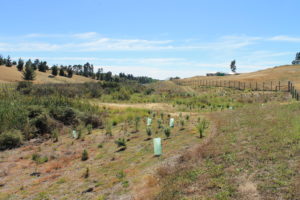

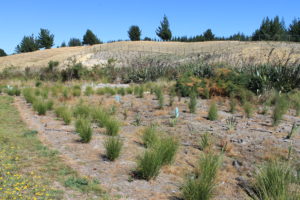
In May 2017 a further eight hundred eco sourced plants were planted to fill the gaps/holes in the original planting. It is our opinion that the cost of maintaining the gaps in a project of this scale is far greater than the cost of replanting them. The project continues to impress with excellent growth rates being achieved. Knapsack spraying has continued to keep competition to a minimum enabling the plants to flourish. Some areas within the project (especially the carex secta & vergata) will require no further maintenance.
The following pictures illustrate exceptional plant growth after two years. The photos below were taken in May 2018 and clearly show the growth that has occurred when compared with the 2017 photos above.
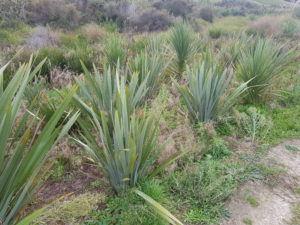
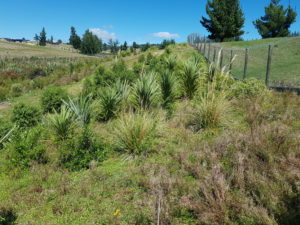
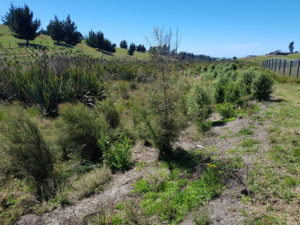
Enhancement
Trapping
An extensive network of traps has been set up within the fenced area. This trap line uses an array of different traps and trapping techniques. It has proven to be very successful with a total of 331 predators being removed since trapping began, a period of 16 months. As shown in the table below 187 Predators have been caught in the last calendar year. The unspecified column represents strikes on Good Nature traps where no carcass is present. Since trapping began fern bird have been sighted within the wetland. It has also been generally noted that the birdlife has improved. NZ Falcon, Kingfisher, Tui, Bellbird, Owls, Pheasants and Quail along with many other bird species have been seen.
| Year and month | Ferret | Hedgehog | Mouse | Possum | Rabbit | Rat | Stoat | Weasel | Unspecified | Total | |
|---|---|---|---|---|---|---|---|---|---|---|---|
| Jun 2017 | 0 | 0 | 35 | 2 | 0 | 3 | 0 | 0 | 20 | 60 | |
| Jul 2017 | 0 | 0 | 4 | 0 | 0 | 1 | 0 | 0 | 14 | 20 | |
| Aug 2017 | 0 | 0 | 3 | 0 | 0 | 2 | 0 | 0 | 13 | 18 | |
| Sep 2017 | 0 | 0 | 2 | 0 | 0 | 1 | 0 | 0 | 0 | 3 | |
| Oct 2017 | 0 | 1 | 6 | 0 | 0 | 0 | 0 | 0 | 3 | 10 | |
| Nov 2017 | 0 | 1 | 0 | 0 | 0 | 1 | 0 | 0 | 0 | 2 | |
| Dec 2017 | 0 | 2 | 0 | 0 | 0 | 4 | 0 | 1 | 2 | 9 | |
| Jan 2018 | 0 | 3 | 3 | 0 | 0 | 5 | 1 | 2 | 0 | 14 | |
| Feb 2018 | 0 | 2 | 0 | 0 | 0 | 6 | 0 | 1 | 0 | 9 | |
| Mar 2018 | 0 | 2 | 2 | 1 | 1 | 1 | 0 | 0 | 5 | 12 | |
| Apr 2018 | 1 | 2 | 2 | 0 | 0 | 16 | 0 | 1 | 0 | 21 | |
| May 2018 | 0 | 0 | 1 | 0 | 0 | 6 | 0 | 0 | 2 | 9 | |
| Total | 1 | 13 | 58 | 3 | 1 | 46 | 1 | 5 | 59 | 187 |
Pest Plant Removal
Although some pest plant species remain within the project (Himalayan honeysuckle, gorse etc.) all the woody steamed plants have been poisoned. Using a Basel treatment method we were able to specifically target the unwanted plants. In this case mainly crack and grey willow, black wattle and poplar were easily identified within the project and systematically poisoned. As you can see from the following photos great results were achieved leaving the unwanted plants dead and not harming the existing natives surrounding them.
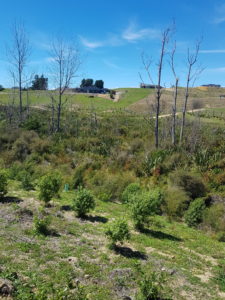
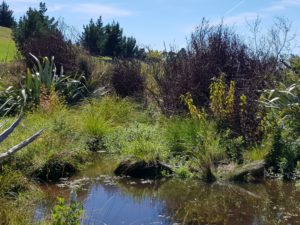
Planting Secondary Species
The establishment of the original plants has created wonderful sheltered areas. We have now been able to introduce many secondary species. Totara, Beach, Matai and Kahikatea have all been planted and will do well in this environment.
In Conclusion
We will continue to monitor and maintain the area in its third year. Some further Knapsack spraying will be required before the area becomes self sustainable. Although it continues, the project is already a success. The area has benefitted immensely from this intervention. Good management will ensure that this project continues to flourish.
